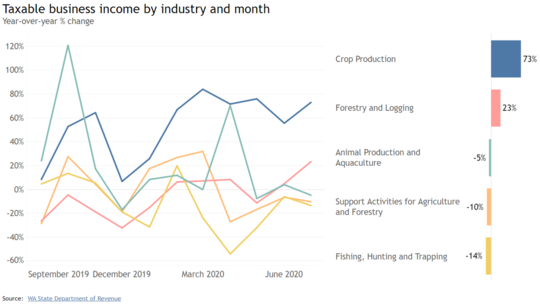Recovery data reveal opportunity amidst ongoing hardship in key sectors and groups
Statewide data gives us a broad overview of Washington’s economy, but it’s when we drill down into the numbers by industry sector, region or demographics that we see important differences. Some of these deeper data offer insight into areas of focus for encouraging equitable and sustainable recovery.
For example, recent monthly data compiled in Commerce’s Economic Recovery Dashboard reveal strong growth in the sector comprised of agriculture, forestry, fishing and hunting, led by a 73% increase in taxable business income for crop production over the same period last year. Forestry and logging increased 23%. That is positive news, especially for many rural and Eastern Washington communities. On the other hand, digging deeper in the sector data, we see fishing and hunting lagging, revealing opportunity to focus on supporting maritime communities, such as the recent relief funding made available to shellfish growers.
Similarly, we see – not surprisingly – that the leisure and hospitality sector continues to suffer mightily across the board. Looking deeper in that sector, a disproportionate impact on performing arts, including spectator sports, emerges with a nearly 70% decrease in income over the same month last year. The pandemic is decimating our creative economy, demanding steps such as our partnership with the Washington State Arts Commission to provide $1.5 million in CARES Act funding for grants to arts and culture nonprofits throughout the state.
Demographic data reveal other out-sized impacts. Continue reading [LINK]
Hard data continue to bear out that black, indigenous and people of color (BIPOC) communities are experiencing greater negative economic impact from COVID. This data drives our work to carve out pockets of funding for assistance programs to help BIPOC business owners and organizations led by and serving members of these communities. Trusted messengers and culturally-relevant communication is essential for ensure equal access to available local, state and federal COVID relief funding and other resources.
We’re also tracking other trends affecting workers, such as the alarming numbers of women leaving the workforce. Recent reporting reveals that women are leaving the workforce at four times that of men in September this year. More study is needed, but primary drivers of these workforce losses during the pandemic are connected with pressures of remote school instruction and women disproportionately represented in many service and hospitality industry jobs. Greater capacity and access to affordable childcare is a critical priority in the best of times, but even more so if we hope to safely restart and rebuild our economy.
These are just a glimpse into the ways our Economic Recovery Dashboard and data-tracking work is already helping us see data in new ways, enabling a more effective focus on high-impact investments to support equitable economic growth and strong communities throughout the state. Already, other states such as California are looking to follow our lead.
I plan to share key takeaways from current data each month in this newsletter.
The dashboard and downloadable data are available to anyone, anytime on Commerce’s website here: Economic Recovery Dashboard

